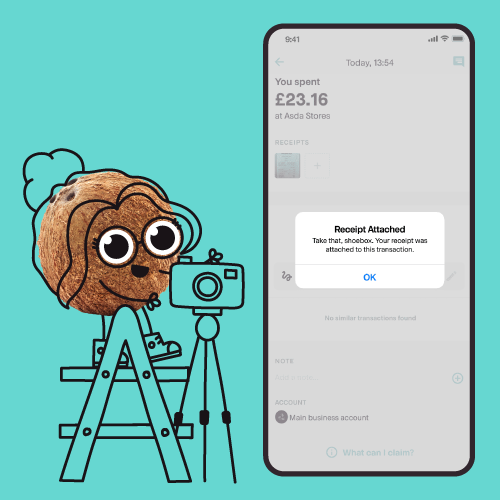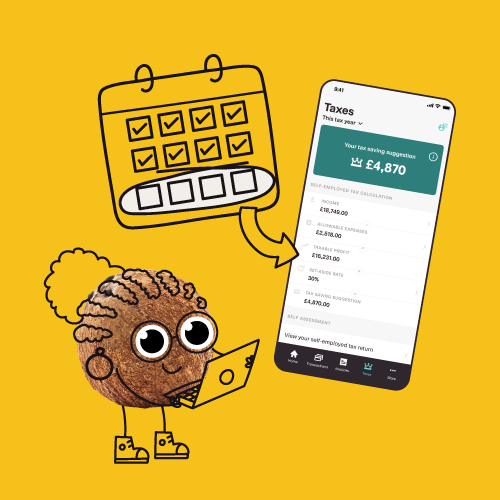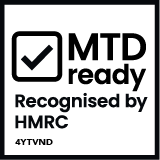Imagine this: you finish a job, send an invoice via Coconut, upload a photo of any expense receipts and boom - your tax records are sorted. Sounds like a dream, right?
Well, with Making Tax Digital for Income Tax on the way, you’ll need digital record-keeping like this in place. But don’t worry. Digital records don’t mean you need to become a data wizard. With Coconut by your side, it’s as easy as snapping receipts and letting the app do all the legwork.
What are digital records?
When the changes come into force in April 2026, MTD for ITSA will require eligible landlords, sole traders and self-employed individuals to keep income records digitally using software that’s compliant with MTD.
For each transaction, you’ll need to record:
- The amount (income or expense)
- The date you received or paid it
- The category - be it travel, rent, materials etc
- Whether it’s self-employment or property income (these must be kept separate)
In its simplest form, HMRC wants to help you stop losing paper receipts! They believe, instead, everything should live safely in one digital home - like Coconut. And in doing so your accounts should be more accurate and stress-free.
What counts as ‘digital enough’?
Under MTD, HMRC requires you to:
- Use a cloud-based accounting software that logs income and expenses automatically - something like Coconut.
- Upload digital images of receipts and link them to the right transactions.
- Connect spreadsheets via a bridging tool that sends the data straight to HMRC. Manual copy and paste are not allowed.
This means you can wave goodbye to paper ledgers and manual data entry into HMRC forms. And you don’t need to hoard every receipt from the year, store them in a shoebox and hope for the best!
Good-to-haves and practical steps
- Start now: Even if you’re not eligible yet, you may be in later years. What’s more, if you start recording everything digitally now, when the time comes, you’ll be an expert.
- Choose your partner: Coconut is proud to be a recognised MTD-compatible software provider. As with everything, not all platforms are created equal so make sure you find one that ticks all the boxes.
- Snap receipts immediately: Once your software is up and running, be sure to get into good habits. When you receive a receipt, take a photo, attach it and you’re done.
- Automate your bank feeds: Even better, when you sign up to Coconut you can let your transactions flow in automatically - saving you time and stress.
- Tidy up monthly: Keep a regular check and reconcile your bank feed to check for missing entries. You should also assign categories every month to make those quarterly updates easier.
- Keep business types separate: Freelance work and rental income must be tracked independently.
- Back up your data: It’s recommended that you keep records for at least five years after each filing deadline.
Pitfalls to avoid
- Leaving transactions unlogged until the end of the year
- Using manual spreadsheets that aren’t digitally linked
- Copying and pasting items from one system to another
- Forgetting that property and self-employment will be deemed as separate businesses for MTD
Biggest no-no: Choosing to do everything manually now and thinking you’ll go digital later. Building good habits from the start means you’ll save time and stress when HMRC flips the MTD switch.
How Coconut helps you stay ahead
At Coconut, we’re one step ahead of the game and have built tools that do the heavy lifting. This includes:
- Automatic transaction imports from your bank account
- Snap-and-store receipts, ready and safe for digital records
- Smart categorisation for transactions
- Real-time insights on income and expenses so you know how much tax to set aside
- Accountant access so you can share your records easily
Even better, we’re building direct HMRC submission tools, so you’ll be ready to go when the changes are implemented.
Sign up today
Digital records might sound technical but it’s really just a smarter version of bookkeeping. Plus, with Coconut, your records, receipts and reports live in one easy place, already MTD-ready.
In fact, if you start keeping digital records with Coconut today, we guarantee that when MTD officially arrives, you’ll barely notice the difference.











